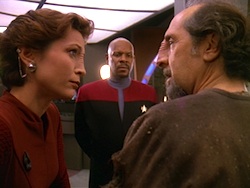“Accession”
Written by Jane Espenson
Directed by Les Landau
Season 4, Episode 16
Production episode 40514-489
Original air date: February 24, 1996
Stardate: unknown
Station log: Keiko’s project on Bajor has ended, and she and Molly return to the station to announce that Keiko is pregnant. O’Brien is surprised—she was only there the one night the last time she came back to the station, and he thought they’d need to make more attempts—but happy.
Vedek Porta brings a couple who just got married to Sisko so they can get the Emissary’s blessing, which Sisko awkwardly provides. (Porta tells Sisko his accent is getting much better.)
An old Bajoran sailing ship comes tumbling out of the wormhole. Remote sensors indicate that nobody entered the wormhole. There’s one passenger, who is beamed to the infirmary. His name is Akorem Laan, and he claims to be the Emissary. He found the wormhole two hundred years ago after his ship suffered through an ion storm in the Denorios Belt. His description of his encounter with the wormhole aliens, or the Prophets, is very similar to Sisko’s in “Emissary,” but he only just left Bajor a few days earlier—yet two centuries have passed. Akorem is shocked to learn that his poetry has survived two centuries. He’s equally shocked to learn that Bajorans no longer use the d’jarras—the strict caste system that was abandoned during the Cardassian occupation.
Sisko is relieved—the prophecies regarding the Emissary make much more sense with Akorem than they do with Sisko, starting with the fact that Akorem is actually Bajoran.
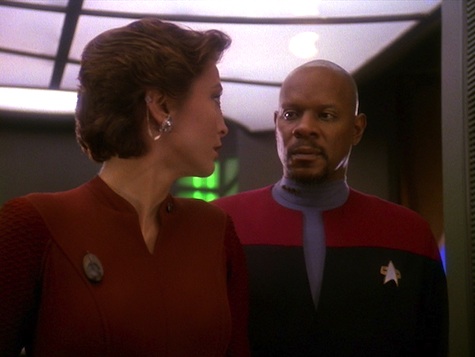
Bashir invites O’Brien into Quark’s for a drink to celebrate his impending fatherhood, but O’Brien seems less than thrilled. He was hoping to have Keiko to himself for a bit now that Molly is getting older.
Akorem makes his first speech as Emissary. He feels that Bajor has lost its way in the wake of the “wound” that was the Cardassian occupation and calls for a return to the d’jarras. That will allow Bajorans to return to the path the Prophets laid out for them, and will serve to return to the time before the occupation, to erase the wounds Cardassia inflicted. Akorem and Porta also tell Sisko that the plan is to make the d’jarras enforceable by law over time, with deportation mentioned as the remedy for those who refuse to follow their ordained path. Sisko points out that such discriminatory practices would lead to the Federation rejecting Bajor’s petition for membership.
The effects start to spread around the station. Kira is nonplussed by a person from a lower d’jarra giving up a seat in the replimat for her. But she also will do as the Emissary says, because she has faith that the Prophets are guiding him. To that end, she tries to fulfill her d’jarra and be an artisan, but her attempts at sculpture are very not good. Porta tells her that she hasn’t given herself completely over to her d’jarra: she needs to resign her commission.
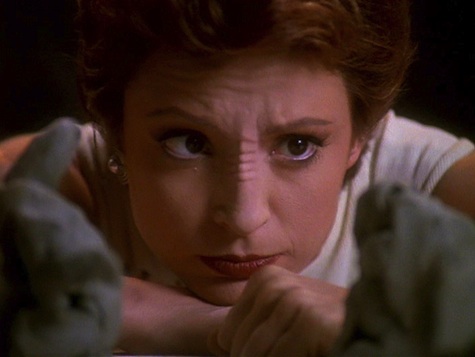
Sisko has a vivid hallucination in which Opaka appears, asking him who he is. Bashir diagnoses it as an orb shadow—people who’ve encountered the Orbs of the Prophets have experienced such symptoms before.
O’Brien finds himself with nothing to do in his own home, as Molly wants to color by herself and Keiko has some final paperwork to do for the survey. He looks longingly at one of his holosuite costumes—which Keiko notices. Later, O’Brien shares a quick drink with Bashir, and they lament that they don’t play darts together or go on the holosuite now that Keiko and Molly are back.
Starfleet is displeased with Sisko because Bajor is now moving away from membership, and his assignment here was supposed to be getting Bajor ready to join the Federation. To make matters worse, Kira announces that she plans to resign and apprentice as an artisan.
Porta kills a fellow vedek, who is from an unclean d’jarra, but refused to give up his vedekhood. Porta doesn’t view himself as having done anything wrong. Sisko is left with no choice but to challenge Akorem’s position as Emissary. But he doesn’t want to divide Bajor by forcing them to choose—instead he invites Akorem to join him in the wormhole so they can ask the Prophets directly.
They take a runabout into the wormhole and wait, eventually encountering the Prophets, who, as usual, take the form of familiar faces in an orange glow. Akorem claims he found them first and Sisko found them later, but the aliens have no concept of first and later. They say that they sent Akorem forward in time for “the Sisko.” Akorem realizes that he isn’t the Emissary, but that he was sent to show Sisko that he needs to embrace being the Emissary. At Sisko’s request, the Prophets send Akorem back to his own time to live out his life, see his wife again.
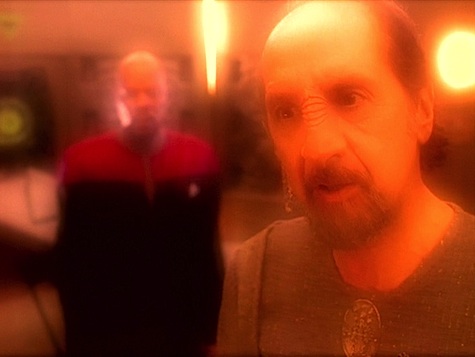
Keiko, seeing just how much O’Brien and Bashir miss hanging out together, tells each of them that the other one has seemed a bit depressed, and maybe he should cheer the other one up and spend some time together. It works like a charm, and Keiko is left to do her work in peace.
Kira gives Sisko one of her awful bird sculptures. “It’s an original Kira Nerys,” she says solemnly. “It might be worth a lot some day.” Sisko dryly replies, “I hear she didn’t make many.” Sisko gave a speech spelling out what happened in the wormhole, and relieves everyone on Bajor when he tells them that the Prophets do not want a return to the d’jarras. Akorem also was able to write more poetry by virtue of the Prophets returning him home, which Sisko is reading when Kira joins him in Quark’s.
Sisko also happily agrees to show up for a young girl’s coming-of-age ceremony to give her the Emissary’s blessing.
The Sisko is of Bajor: This is the first time the Prophets say that they are of Bajor and that “the Sisko” is of Bajor. Sisko finally accepts that his role is that of Emissary of the Prophets.
Don’t ask my opinion next time: In “The Circle,” Kira said she has no artistic talent whatsoever, and she spends her temporary time as a member of the artisans’ d’jarra proving it with some really awful bird sculptures.
There is no honor in being pummeled: When told that Keiko is having a baby, Worf goes into a severe panic. “Now?” he asks, recalling Keiko’s last time giving birth and his critical role in it. He’s relieved that it’s not for seven months, and he announces fervently that he’ll be far away from the station when the baby’s due. (As it happens, he won’t be, which is a blown opportunity, but we’ll discuss that when we get to “The Begotten.”)
Preservation of mass and energy is for wimps: Odo has trouble comprehending how Kira can so easily go from believing Sisko is the Emissary to believing that Akorem is. Kira replies by paraphrasing St. Thomas Aquinas’s line, “To one who has faith, no explanation is necessary. To one without faith, no explanation is possible.”
Rules of Acquisition: Quark reminisces about reading children’s stories to Nog when he was a baby: “See Brak acquire. Acquire, Brak, acquire!”
What happens on the holosuite stays on the holosuite: Bashir and O’Brien are so caught up in playing World War I flying ace in the holosuite that they have to rush to finish tidying up O’Brien’s quarters in preparation for Keiko’s return.
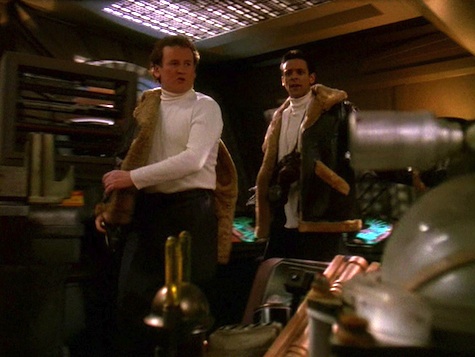
No sex, please, we’re Starfleet: Apparently the O’Briens only needed one night of nookie to conceive. Wah-HEY!
Keep your ears open: “No more ceremonies to attend, no more blessings to give. No more prophecies to fulfill. I’m just a Starfleet officer again; all I have to worry about are the Klingons, the Dominion and the Maquis. I feel like I’m on vacation.”
Sisko upon realizing he isn’t the Emissary anymore.
Welcome aboard: Rosalind Chao and Hana Hatae are back as Keiko and Molly, and Camille Saviola makes her final appearance as the image of Opaka. Richard Libertini, one of the great character actors, plays Akorem. But this episode’s Robert Knepper moment is Robert Symonds as Porta—to me, Symonds will always be Colonel Horace Baldwin, who appeared in two episodes of M*A*S*H (in “Fade Out, Fade In,” when he was responsible for sending Winchester to the 4077th, and “No Laughing Matter,” one of the single funniest episodes of the show ever).
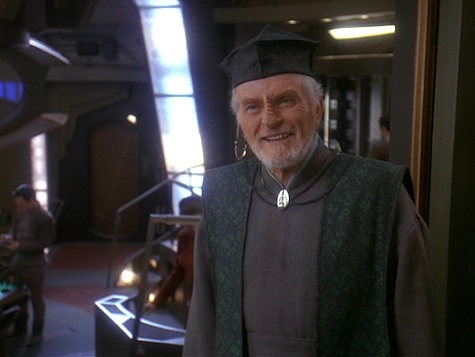
Trivial matters: This is one of the first produced scripts by Jane Espenson, who submitted spec scripts to TNG, which led to this assignment. Espenson has gone on to become one of the most popular and prolific writers of genre television, having penned multiple episodes of Buffy the Vampire Slayer, Angel, Firefly, Eureka, Battlestar Galactica, Caprica, The Dollhouse, Tru Calling, Torchwood, and tons more. She is the co-creator of Warehouse 13 and Husbands, and is currently a producer and writer for both Once Upon a Time and Once Upon a Time in Wonderland.
Ira Steven Behr had wanted to cast David Warner—who played Gul Madred in TNG’s “Chain of Command, Part II” and also appeared in Star Trek V and Star Trek VI—as Akorem, but he was unavailable.
Sisko and Kira have been trying out the four-shift rotation that Kira suggested in “Starship Down,” and they agree to make it permanent.
Akorem’s ship was the same design (and used the same model) as the solar sailing ship Sisko built in “Explorers.”
Worf delivered Molly in the TNG episode “Disaster,” and the thought of being in any way involved in delivering her second child fills him with a nameless dread.
Neither First Minister Shakaar nor Kai Winn are seen in the episode, but they are discussed. Akorem says that he’s not asking the former to step down as First Minister to go back to farming, but he and Porta are confident that by the next election, no one would dream of electing a farmer as First Minister. As for the latter, she supports the return to the d’jarras, and Akorem also mentions in passing to Sisko that Winn fears Sisko.
The changes in the timeline brought about by Akorem’s time travel are looked into by the Department of Temporal Investigations in the DTI novel Watching the Clock by Christopher L. Bennett.
Your humble rewatcher’s Demons of Air and Darkness established the Akorem Laan Museum on Bajor, and the Prophecy and Change short story “The Orb of Opportunity” by Andy Mangels & Michael A. Martin established a Bajoran Milita ship called the Akorem Laan.
Porta is seen as the cleric at the Singha Refugee Camp during the occupation in the Terok Nor novel Night of the Wolves by S.D. Perry & Britta Dennison.
Walk with the Prophets: “You are of Bajor.” In 2011, Star Trek Magazine celebrated the 45th anniversary of Trek by doing a feature on every 45th episode of the various series, order determined by first air date. One of those “45s” was this episode, and I drew the assignment to write it up. When I reviewed the episode, I nearly fell over from shock at the writer credit. In February 1998, the name Jane Espenson made no impression on me whatsoever, but within a few years, her credit would be one that would provoke confidence that you were about to watch a well-crafted episode. She became a trusted part of Joss Whedon’s stable of writers, and she’s gone on to become a force in genre TV writing. (I actually first met her at Dragon Con in 2000, alongside Tim Minear. The three of us and Christopher Golden did a panel on writing the Buffy characters, and she and Tim were both pretty shocked that anyone cared about what writers thought…)
One of Espenson’s hallmarks has been strong characterization, and this episode certainly has plenty of that, mostly focused on Sisko and Kira. Both of them have their faith severely tested, though calling it “faith” in Sisko’s case is pushing it. He’s sort of coasted along as the Emissary but never really wanted it—as recently as ten episodes ago in “Starship Down” he contrived a Gamma Quadrant mission in order to avoid a festival in his honor—but in this episode the Prophets basically force him to commit to it by providing him with a much worse alternative. There’s an old saw that the best leaders are the ones who don’t want to be leaders, and this episode embodies that concept. Akorem dives into being the Emissary with both feet, and decides that the best way to fix Bajor is to make it just like it was two centuries ago, ’cause that always works.
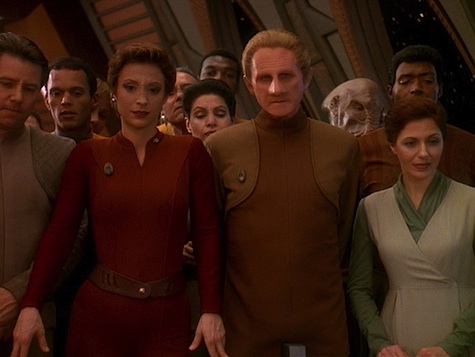
Kira, meanwhile, gets a kick in the teeth of her faith. After she lectures Odo on the subject of how faith is just one of those things you have, she has it challenged by Akorem’s dumbshit plan to restore an outdated caste system. Everyone goes along with it because religion is pretty much what got Bajor through the occupation. Faith was what kept a lot of Bajorans from giving up. So now when they’re confronted with a new Emissary, they do as he says, even though it’s stupid.
And that’s the danger. One of the fascinating things about Star Trek religions is that most of the ones we get to see actually have a tangible base: one-offs like Landru and Vaal (both computers), or the Edo’s orbiting thingie and the Ocampa Caretaker in Voyager’s pilot (extradimensional beings), or the Greeks of Earth (really powerful aliens). And of course we have the most consistently seen spiritual peoples, the Bajorans (who worship actual aliens who reside in the wormhole) and the Klingons (who killed their gods, but whose messianic figure is a historical personage—they have his DNA and everything).
Of course, that makes this particular religious civil war a lot easier to settle. Sisko deciding, after the cold-blooded murder of a vedek, to challenge Akorem’s position would, under most circumstances, result in an awful civil war as they compete for the hearts and minds of the Bajoran faithful. But they don’t need to bother with that nonsense, because they’ve got the Prophets right there in the wormhole. And sure enough, Akorem finds out that he got it horribly horribly wrong.
It would be nice to see what the consequences of this really were long-term—after all, not everyone is necessarily going to take Sisko at his word that Akorem is safely back in his own time, and that civil war they avoided could still happen—but the point of the episode isn’t about what Akorem’s appearance does to Bajor, it’s what it does to Sisko. The Prophets want him to crap or get off the pot.
One of the admirable things about DS9 is that its producers have always spoken honestly about the show (this makes The Star Trek: Deep Space Nine Companion infinitely more satisfying as a read than any of the companions for the other Trek shows), and one of the things Ira Steven Behr expressed about this episode was disappointment in Richard Libertini’s performance, especially since they wanted David Warner for the role.
Well, I’m here to say that Behr was dead wrong, and he got the right guy in Libertini. If the guy who played Gul Madred is Akorem, then you know he’s a bad guy. But what makes Libertini and also Robert Symonds so effective is the fact that they’re not evil. The scariest moments in the episode are when Akorem matter-of-factly says that deportation is the alternative to following the d’jarras, and when Porta confesses to the murder, blissfully unaware that he’s done anything wrong. This is the surety of the fanatic, and it works because there is absolutely no evil intent. They’re doing what they think is right—and what they think is right is awful. And that’s the danger, that’s what Sisko needs to commit to being against.
Warp factor rating: 7
Keith R.A. DeCandido reminds everyone that The Klingon Art of War is available for preorder from Amazon, Barnes & Noble, Indie Bound, or directly from the publisher. It’ll be out in May, and he’ll be debuting it at TrekTrax Atlanta at the end of April.










